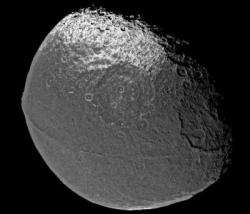What’s this ridge on Iapetus?

The strangest feature on Iapetus is the equatorial ridge. What could possibly create a feature like this?
To paraphrase the British geneticist J.B.S Haldane, “in my suspicion, the Universe is not only stranger than we suppose, it’s stranger than we can suppose.” The context was life and evolution, but he might as well been talking about Saturn’s moons. Those teeny worlds are some of the strangest places we’ve ever seen.
Titan is a massive moon with an atmosphere thicker than Earth’s. If it wasn’t for the bone crippling cold and unbreathable atmosphere, you could wear a pair of wings and fly around in the Titanic skies.
There’s Enceladus, an icy moon that blasts water out into space through geysers at its southern pole. But the Saturnian moon that fascinates me the most has got to be Iapetus, also known as Saturn’s yin-yang moon.
The two sides of Iapetus. Credit: Cassini
Here’s a photo captured by Cassini. Check out the bizarre surface features, where half of the moon is icy white and the other is brownish red. Astronomers believe this strange coloration comes from the ice on the warmer side sublimating away, leaving this darker material beneath.
Saturn’s relatively thin main rings are about 250,000 km (156,000 miles) in diameter. Credit: NASA/JPL-Caltech/SSI/J. Major
Sure that’s a bit odd, but the strangest feature on Iapetus is the equatorial ridge. This feature measures 1,300 km long and it makes the moon look like a space walnut. Because of the heavy cratering on the ridge, astronomers know that it’s ancient, nearly as old as the moon itself. At 13 kms high, it’s tall enough to keep out the most persnickety white walker or wildling mammoth & giant battalion.
What could possibly create a feature like this?
Astronomers are of a few camps. The first think it formed through convective activity early on in the moon’s history. Saturn pulls Iapetus with its tremendous gravity, and the moon undergoes massive tidal forces. This generates heat in the moon’s interior, and it might have caused it to blob out at the equator.
A second idea is that Iapetus consumed one of Saturn’s rings, billions of years ago. The moon might have slowly wandered through the ring plane, and accreted all the ring material, like snow piling up in front of a plow.
A third is that Iapetus was smashed into by a massive asteroid billions of years ago. This impact caused the moon to fly apart, but then mutual gravity pulled it back together. The force of this recombination squeezed out material at the equator, which then solidified in place.
Alternately, it might be a walnut from a Galactus family Christmas stocking. So which is it?
It turns out that Saturn has two more moons in its system with similar equatorial ridges. Its moon Atlas is just 15 km across, but it’s dominated by an equatorial ridge. It looks like a UFO, and Pan has a similar feature.
Astronomers know that both of these created their ridges by pulling material out of the rings and piling it up on their surface. This is the mechanism that seems to match what’s going on with Iapetus.
One mystery, is how distantly Iapetus orbits Saturn. There’s no ring that far out, so where did it get the material to consume? Is it possible that Iapetus drifted outward, or had a ring system of its own?
You want puzzles? Iapetus is one of the strangest places in the Solar System, and it would be my candidate for a future orbiter or lander. Let’s explore it closer.



 Creators of mankind
Creators of mankind Description of “Tall white aliens”
Description of “Tall white aliens” Where they came from?
Where they came from? About hostile civilizations
About hostile civilizations The war for the Earth
The war for the Earth “Tall white aliens” about eternal life
“Tall white aliens” about eternal life Video: “Nordic aliens”
Video: “Nordic aliens” Aliens
Aliens Alien encounters
Alien encounters The aliens base
The aliens base UFO
UFO Technology UFO
Technology UFO Underground civilization
Underground civilization Ancient alien artifacts
Ancient alien artifacts Military and UFO
Military and UFO Mysteries and hypotheses
Mysteries and hypotheses Scientific facts
Scientific facts


















